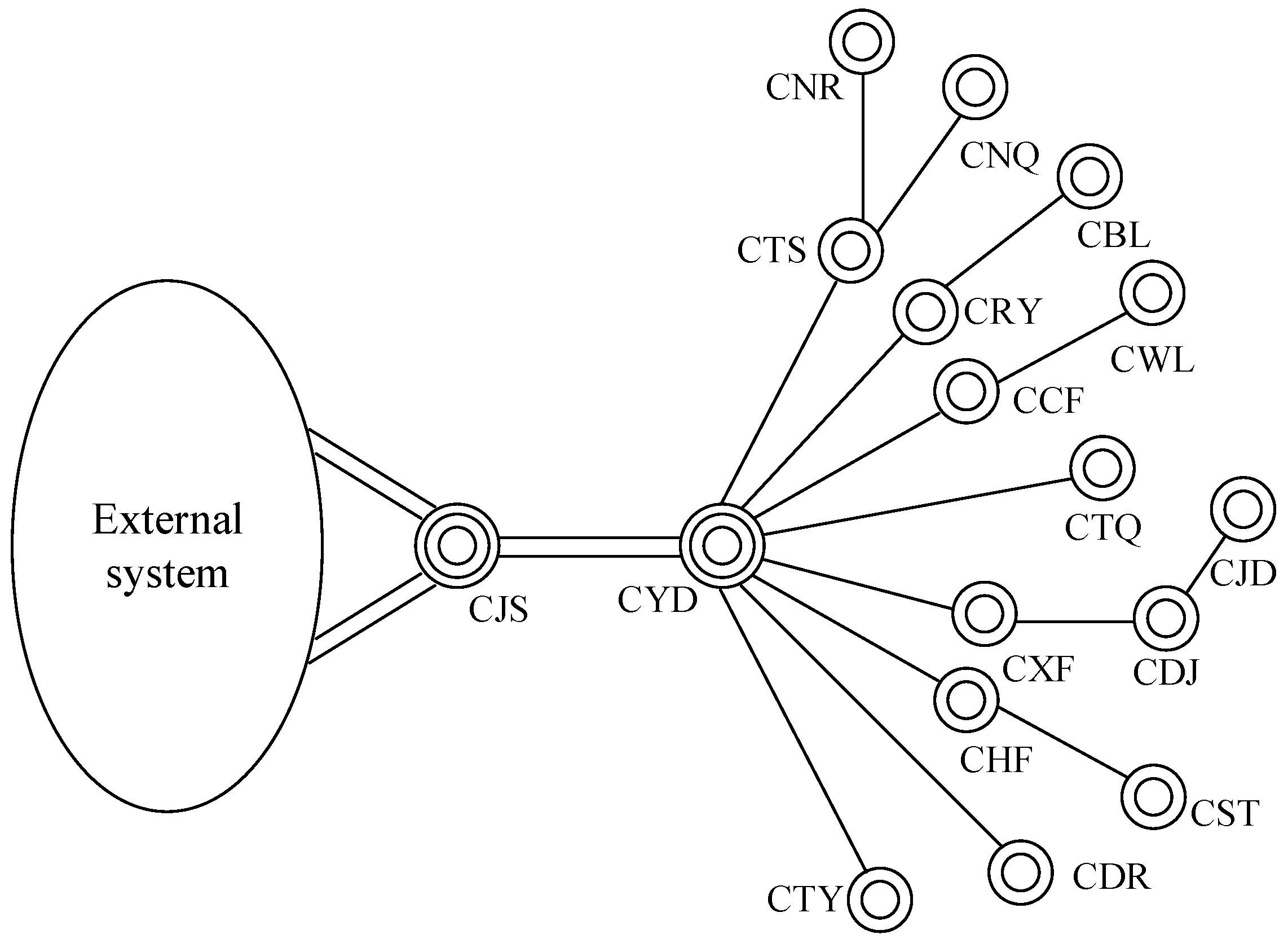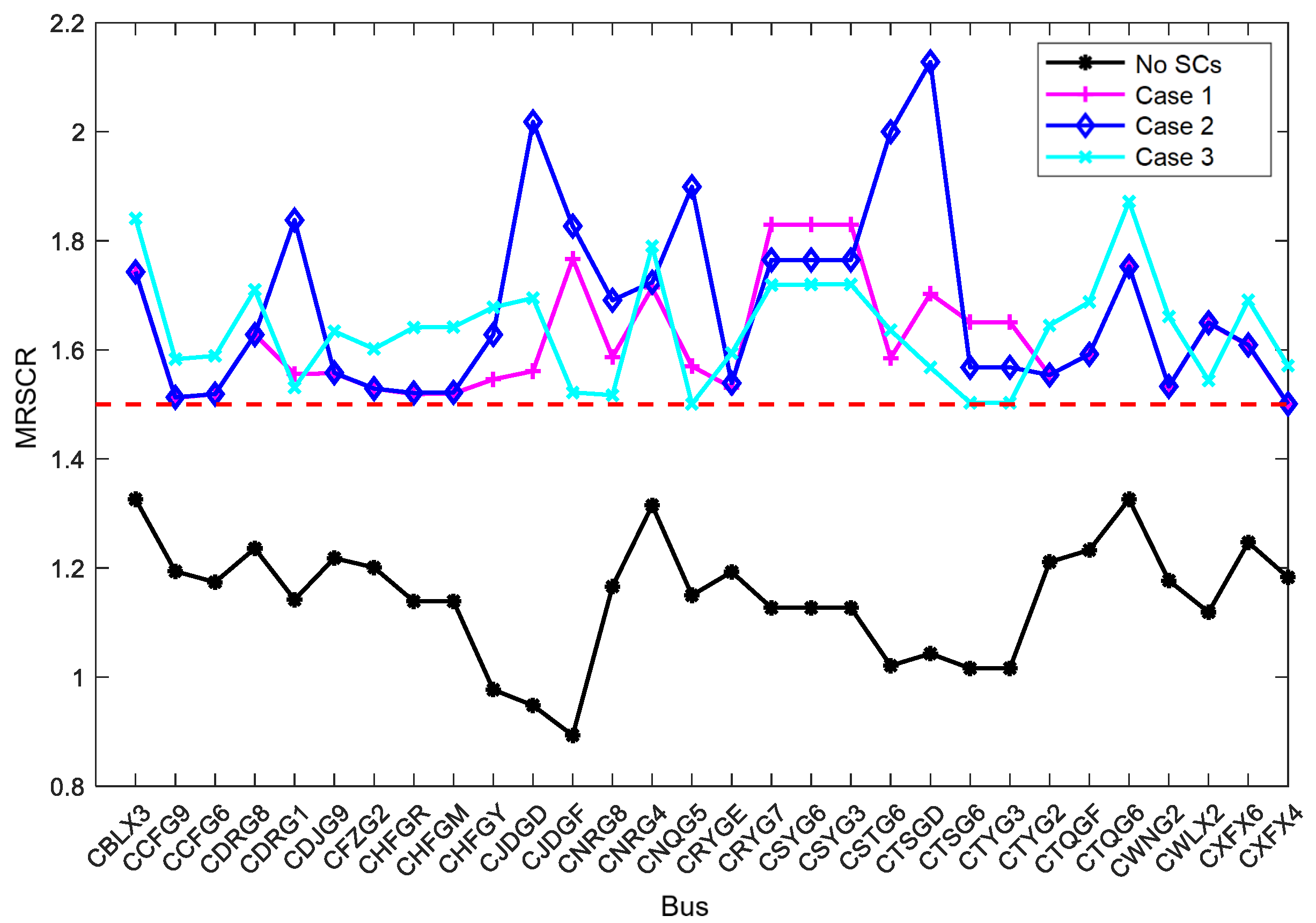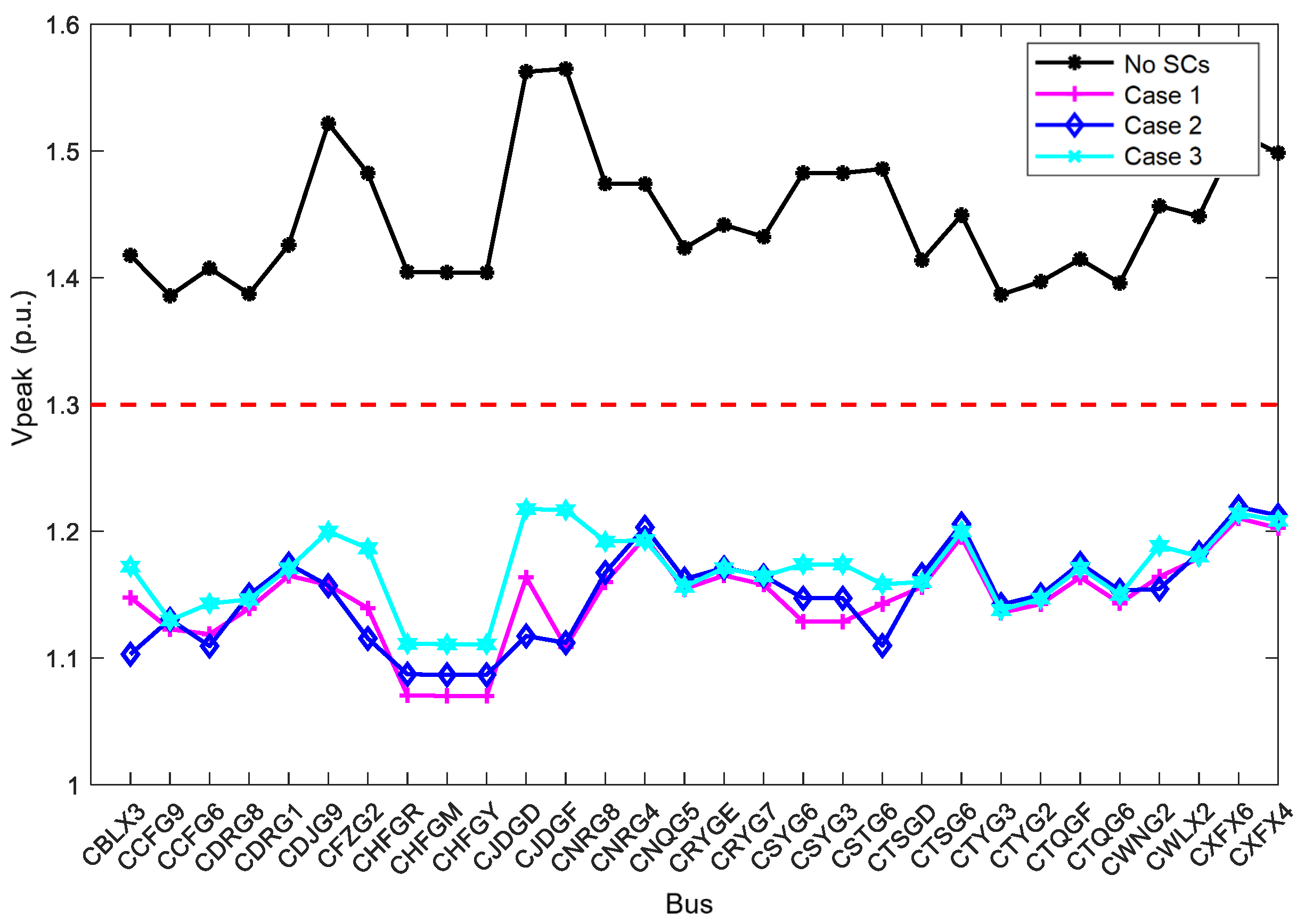Optimal Synchronous Condenser Placement in Renewable Energy Bases to Meet Renewable Energy Transfer Capacity Requirements
Abstract
1. Introduction
- A novel optimization model is proposed that supports both centralized and distributed deployment of SCs with multiple capacities and vendor types. This model enables flexible multi-site and multi-vendor selection, thereby enhancing the engineering applicability and economic feasibility of SC deployment schemes in practical grid scenarios.
- A comprehensive objective function and constraint system is developed by jointly considering investment cost, operation and maintenance expenses, and engineering constraints such as short-circuit ratio (SCR), transient overvoltage, and available installation space. By introducing SCR sensitivity indicators, the original non-linear optimization problem is reformulated as a mixed integer linear programming model (MILP). A decomposition-based iterative solution strategy is further employed to significantly reduce the computational burden associated with transient stability simulations, making the method suitable for large-scale renewable energy transmission applications.
- Simulation results demonstrate that the proposed method can generate multiple feasible SC deployment schemes under delivery capacity and security constraints. In addition, cost–benefit comparisons among solutions are provided, highlighting the capability of the method to support decision-making in real-world engineering projects. These results confirm the strong potential of the proposed approach for practical implementation in future power systems with high penetration of renewables.
2. Mathematical Model for the Optimal Configuration of Synchronous Condensers in Renewable Energy Bases
2.1. Objective Function
2.2. Constraints
3. Solution Strategy Based on Short-Circuit Ratio Sensitivity
4. Investment–Benefit Metrics for SC Deployment
5. Case Study
5.1. System Structure and Parameter Settings
5.2. Configuration Schemes and Cost Estimation
- Scheme 1: Candidate buses include only high-voltage buses (110 kV, 220 kV, and 500 kV) at renewable stations and collector substations.
- Scheme 2: Candidate buses include only low-voltage buses (10 kV and 35 kV).
- Scheme 3: The 500 kV, 220 kV, 110 kV, 35 kV, and 10 kV buses are considered candidates.
5.3. SCR and Transient Overvoltage Validation
5.4. Benefit Analysis
6. Conclusions
- A flexible hybrid configuration model is developed that supports the selection of multi-site and multi-vendor equipment for centralized and distributed deployment. This enhances the engineering applicability and economic viability of SC configuration schemes.
- An objective function and constraint system is constructed that jointly considers investment cost, operational and maintenance expenses, and engineering feasibility. By combining decomposition iteration strategies with SCR sensitivity analysis, the original nonlinear problem is linearized and solved efficiently. This approach is well-suited to large-scale renewable energy transmission scenarios.
- Simulation results demonstrate that the proposed method can generate multiple feasible deployment schemes under delivery capacity and security constraints, along with corresponding cost–benefit comparisons. The methodology exhibits great potential for practical implementation.
- Further exploration of the temporal variability of system operating conditions and multiscenario adaptability, to improve the robustness of deployment strategies under uncertainty.
- Integration of SCs with other dynamic reactive power support devices (e.g., STATCOMs, grid-forming energy storage systems) to develop a complementary joint optimization model.
- Investigation of the interaction between SC configuration and ancillary service market clearing mechanisms, to provide technical support for market-oriented deployment strategies.
- Development of an AI-based configuration recommendation system. By introducing machine learning models to identify sensitivity distributions and the importance of buses, the computational efficiency and scalability of the method can be further enhanced in large-scale systems.
7. Patents
- Sheng, H.; Ma, J.; Zhang, Z.; Zeng, Y. Optimal configuration method, system, device, and medium for synchronous condensers in renewable energy bases. CN117913844A. China National Intellectual Property Administration, Filed 2024-03-15, Published 2024-04-129
Author Contributions
Funding
Data Availability Statement
Acknowledgments
Conflicts of Interest
Abbreviations
| MRSCR | Multiple renewable energy stations short-circuit ratio |
| SC | Synchronous condenser |
| SCR | Short-circuit ratio |
| TOV | Transient overvoltage |
| O&M | Operating and maintenance |
| PSO | Particle swarm optimization |
| GA | Genetic algorithms |
| UHV | Ultra-high-voltage |
| PCC | Point of common coupling |
| MILP | Mixed integer linear programming |
| Mvar | Megavolt-ampere reactive, a unit of reactive power |
References
- Du, W.; Luo, Y.; Li, Y.; Wu, L.; Zhao, F.; Sun, D. Reviews of transient overvoltage problem cause by extra reactive power in large scale wind power systems. Proc. CSEE 2022, 42, 3224–3238. (In Chinese) [Google Scholar] [CrossRef]
- Yunfeng, W.; Youhang, Y.; Pengxiang, X.; Xintong, Y.; Linlin, Y.; Xiaoliang, J. Review on the new energy accommodation capability evaluation methods considering multi-dimensional factors. Proc. CSEE 2024, 44, 127–147. (In Chinese) [Google Scholar] [CrossRef]
- Wang, Y.; Zhang, Y.; Zhou, Q.; Li, Z.; Jiang, Y.; Tang, Y.; Wu, J.L.; Gao, C.; Tu, J.Z.; Shen, C. Study on application of new generation large capacity synchronous condenser in power grid. Power Syst. Technol. 2017, 41, 22–28. (In Chinese) [Google Scholar] [CrossRef]
- Zhou, Y.; Sun, H.; Xu, S.; Wang, X.; Zhao, B.; Zhu, Y. Synchronous condenser optimized configuration scheme for power grid voltage strength improvement. Power Syst. Technol. 2022, 46, 3848–3856. (In Chinese) [Google Scholar] [CrossRef]
- Sun, H.; Xu, S.; Xu, T.; Guo, Q.; He, J.; Zhao, B.; Yu, L.; Zhang, Y.; Li, W.; Zhou, Y.; et al. Definition and index of short circuit ratio for multiple renewable energy stations. Proc. CSEE 2021, 41, 497–505. (In Chinese) [Google Scholar] [CrossRef]
- Yang, H.; Liu, H.; Ding, Z.H.; Sun, Z.L.; Liu, C.; Cai, G.W.; Zhang, G.L. Two-stage optimal configuration of condenser for high-proportion wind power sending-end power grid considering short circuit ratio increase and transient overvoltage suppression. Power Syst. Technol. 2024, 48, 540–551. (In Chinese) [Google Scholar] [CrossRef]
- Suo, Z.; Li, H.; Zhang, F.; Jiang, W.; Wang, F.; Hu, A.P. Optimal configuration of a distributed synchronous condenser for an HVDC sending-end system with a high-proportion of renewable energy. Power Syst. Prot. Control 2022, 50, 133–141. (In Chinese) [Google Scholar] [CrossRef]
- Hadavi, S.; Saunderson, J.; Mehrizi-Sani, A.; Bahrani, B. A Planning Method for Synchronous Condensers in Weak Grids Using Semi-Definite Optimization. IEEE Trans. Power Syst. 2023, 38, 1632–1641. [Google Scholar] [CrossRef]
- Haijun, C.; Chao, H.; Fusuo, L.; Xianbo, K.; Yuqinag, H. Research on optimal allocation method of synchronous condensers for improving transient voltage stability level of weak sending-end power grid. Power Syst. Prot. Control 2019, 47, 90–95. (In Chinese) [Google Scholar] [CrossRef]
- Li, Q.; Chen, P.; Xu, Z.; Sheng, H. Optimal configuration for new large capacity synchronous condenser considering transient voltage stability in multi-fed DC. Proc. CSU-EPSA 2025, 37, 91–101. (In Chinese) [Google Scholar] [CrossRef]
- Richard, L.; Nahid-Al-Masood; Saha, T.K.; Tushar, W.; Gu, H. Optimal allocation of synchronous condensers in wind dominated power grids. IEEE Access 2020, 8, 45400–45410. [Google Scholar] [CrossRef]
- Nguyen, H.T.; Yang, G.; Nielsen, A.H.; Jensen, P.H. Combination of synchronous condenser and synthetic inertia for frequency stability enhancement in low-inertia systems. IEEE Trans. Sustain. Energy 2019, 10, 997–1005. [Google Scholar] [CrossRef]
- Wang, K.; Li, Z.; Yang, C.; Li, Q.; Liu, C.; Xin, H. Siting method of synchronous condenser for small-signal stability improvement of large-scale renewable energy base. Autom. Electr. Power Syst. 2022, 46, 64–74. (In Chinese) [Google Scholar] [CrossRef]
- Hadavi, S.; Mansour, M.Z.; Bahrani, B. Optimal allocation and sizing of synchronous condensers in weak grids with increased penetration of wind and solar farms. IEEE J. Emerg. Sel. Top. Circuits Syst. 2021, 11, 199–209. [Google Scholar] [CrossRef]
- Wang, Z.; Liu, M.; Li, H.; Qin, J.; Guo, J.; Bai, K. Optimal configuration method of synchronous condenser to improve delivery capacity of new energy cluster in weak grid. Electr. Power Autom. Equip. 2024, 44, 30–36+44. (In Chinese) [Google Scholar] [CrossRef]
- Ma, X.; Xue, F.; Gu, W.; Li, H.; Lv, S. Optimal configuration method of grid-forming energy storage and distributed synchronous condenser considering constraints of MRSCR. Electr. Power Autom. Equip. 2025, 45, 40–46+64. (In Chinese) [Google Scholar] [CrossRef]
- Wang, J.; Hou, Q.; Zhang, N. Synchronous Condenser Placement for Multiple HVDC Power Systems Considering Short-Circuit Ratio Requirements. IEEE Trans. Power Syst. 2025, 40, 765–779. [Google Scholar] [CrossRef]
- Arun, M.; Barik, D.; Chandran, S.R.; Praveenkumar, S.; Tudu, K. Economic, policy, social, and regulatory aspects of AI-driven smart buildings. J. Build. Eng. 2025, 99, 111666. [Google Scholar] [CrossRef]
- CN117913844A; Optimal Configuration Method, System, Device, and Medium for Synchronous Condensers in Renewable Energy Bases. CNIPA: Beijing, China, 2024.
- CIGRE. Systems with Multiple DC Infeed; CIGRE Working Group B4.41; CIGRE: Paris, France, 2008. [Google Scholar]
- CIGRE. Connection of Wind Farms to Weak AC Networks; CIGRE Working Group B4.41; IGRE: Paris, France, 2016. [Google Scholar]
- Zhang, F.; Xin, H.; Wu, D.; Wang, Z.; Gan, D. Assessing strength of multi-infeed LCC-HVDC systems using generalized short-circuit ratio. IEEE Trans. Power Syst. 2019, 34, 467–480. [Google Scholar] [CrossRef]
- GB/T 40581-2021; Technical Guidelines for Power System Security and Stability Calculations. The National Technical Committee for Standardization of Power System Operation and Control: Beijing, China, 2021. (In Chinese)
- GB/T 19963.1-2021; Technical Specification for Connecting Wind Farm to Power System—Part 1: On Shore Wind Power. China Electricity Council: Beijing, China, 2021. (In Chinese)
- GB/T 19964-2024; Technical Requirements for Connecting Photovoltaic Power Station to Power System. China Electricity Council: Beijing, China, 2024. (In Chinese)



| Parameters | 10 Mvar | 20 Mvar | 50 Mvar | 100 Mvar |
|---|---|---|---|---|
| Plant Footprint Area (m × m) | 17 × 10 | 20 × 10 | 27 × 14 | 37 × 23 |
| Total Construction Cost ($1 M) | 2.535 | 3.521 | 5.634 | 9.859 |
| Retrofit Cost ($1 M) | 0.000 | 0.000 | 0.000 | 0.000 |
| Annual Major Maintenance Cost ($1 M) | 0.095 | 0.132 | 0.211 | 0.370 |
| Annual Minor Maintenance Cost ($1 M) | 0.038 | 0.053 | 0.085 | 0.148 |
| Annual Energy Loss Cost ($1 M) | 0.133 | 0.267 | 0.573 | 1.333 |
| Indicator Items | Case 1 | Case 2 | Case 3 |
|---|---|---|---|
| Location/ Capacity (Mvar) of Installed SCs | CDJ21/100 | CBL34/50 | CBL21/50 |
| CHF11/50 | CDJ34/10 | CCF34/10 | |
| CJD21/50 | CFZ34/50 | CDJ21/50 | |
| CNR21/50 | CJD35/50 | CJD34/50 | |
| CRY21/50 | CJD34/50 | CNR35/20 | |
| CST21/50 | CNR35/20 | CSY21/50 | |
| CXF11/50 | CST34/50 | CST21/50 | |
| CWN34/20 | |||
| Investment Cost ($1 M) | 43.662 | 37.746 | 34.225 |
| Retrofit Cost ($1 M) | 0.000 | 0.000 | 0.000 |
| Major Repair Cost ($1 M/y) | 1.637 | 1.415 | 1.283 |
| Minor Repair Cost ($1 M/y) | 0.655 | 0.566 | 0.513 |
| Energy Loss Cost ($1 M/y) | 5.181 | 3.873 | 3.607 |
| Annualized Cost ($1 M/y) | 10.992 | 8.897 | 8.162 |
| Indicator Items | No SCs | Case 1 | Case 2 | Case 3 |
|---|---|---|---|---|
| Max. simultaneity factor (%) | 0.37 | 0.73 | 0.72 | 0.72 |
| Annual Utilization Hours (h) | 1649.73 | 2049.60 | 2046.73 | 2046.58 |
| Est. Annual Generation (GWh) | 4603.56 | 5719.41 | 5711.39 | 5710.97 |
| Increased Generation (GWh) | / | 1115.84 | 1107.82 | 1107.40 |
| Increased Annual Revenue ($1 M) | / | 76.37 | 75.83 | 75.80 |
| Curtailment Rate (%) | 21.08 | 1.95 | 2.09 | 2.10 |
| Payback Period (year) | / | 7.50 | 4.94 | 4.17 |
| Station | Est. Annual Gen. (GWh) | Inc. Gen. (GWh) | Inc. Revenue ($1 M/y) |
|---|---|---|---|
| CBL | 366.18 | 89.35 | 6.12 |
| CCF | 274.50 | 66.98 | 4.58 |
| CDR | 266.26 | 64.97 | 4.45 |
| CDJ | 274.50 | 66.98 | 4.58 |
| CFZ | 34.31 | 8.37 | 0.57 |
| CHF | 194.89 | 47.56 | 3.26 |
| CJD | 548.99 | 133.96 | 9.17 |
| CRY | 450.17 | 109.85 | 7.52 |
| CSY | 181.17 | 44.21 | 3.03 |
| CST | 271.75 | 66.31 | 4.54 |
| CTS | 382.40 | 77.64 | 5.31 |
| CTY | 266.26 | 64.97 | 4.45 |
| CTQ | 456.58 | 111.41 | 7.63 |
| CWL | 183.91 | 44.88 | 3.07 |
| CXF | 450.45 | 109.92 | 7.52 |
| Subtotal | 4603.57 | 1107.41 | 75.80 |
Disclaimer/Publisher’s Note: The statements, opinions and data contained in all publications are solely those of the individual author(s) and contributor(s) and not of MDPI and/or the editor(s). MDPI and/or the editor(s) disclaim responsibility for any injury to people or property resulting from any ideas, methods, instructions or products referred to in the content. |
© 2025 by the authors. Licensee MDPI, Basel, Switzerland. This article is an open access article distributed under the terms and conditions of the Creative Commons Attribution (CC BY) license (https://creativecommons.org/licenses/by/4.0/).
Share and Cite
Sheng, H.; Zhang, S.; Zhao, T.; Hao, J.; Li, Q.; Xin, G.; Chen, R.; Wang, X.; Ren, X. Optimal Synchronous Condenser Placement in Renewable Energy Bases to Meet Renewable Energy Transfer Capacity Requirements. Energies 2025, 18, 4267. https://doi.org/10.3390/en18164267
Sheng H, Zhang S, Zhao T, Hao J, Li Q, Xin G, Chen R, Wang X, Ren X. Optimal Synchronous Condenser Placement in Renewable Energy Bases to Meet Renewable Energy Transfer Capacity Requirements. Energies. 2025; 18(16):4267. https://doi.org/10.3390/en18164267
Chicago/Turabian StyleSheng, Hao, Siqi Zhang, Tianqi Zhao, Jing Hao, Qi Li, Guangming Xin, Rui Chen, Xiaofei Wang, and Xiang Ren. 2025. "Optimal Synchronous Condenser Placement in Renewable Energy Bases to Meet Renewable Energy Transfer Capacity Requirements" Energies 18, no. 16: 4267. https://doi.org/10.3390/en18164267
APA StyleSheng, H., Zhang, S., Zhao, T., Hao, J., Li, Q., Xin, G., Chen, R., Wang, X., & Ren, X. (2025). Optimal Synchronous Condenser Placement in Renewable Energy Bases to Meet Renewable Energy Transfer Capacity Requirements. Energies, 18(16), 4267. https://doi.org/10.3390/en18164267





